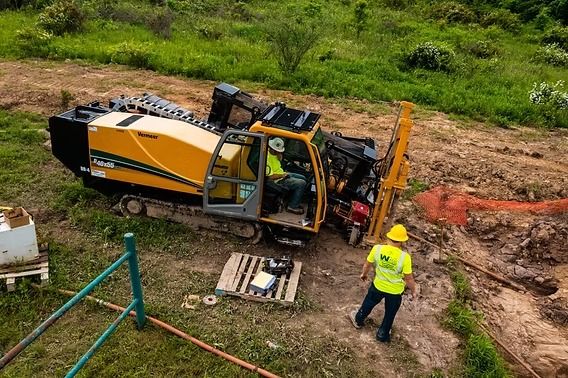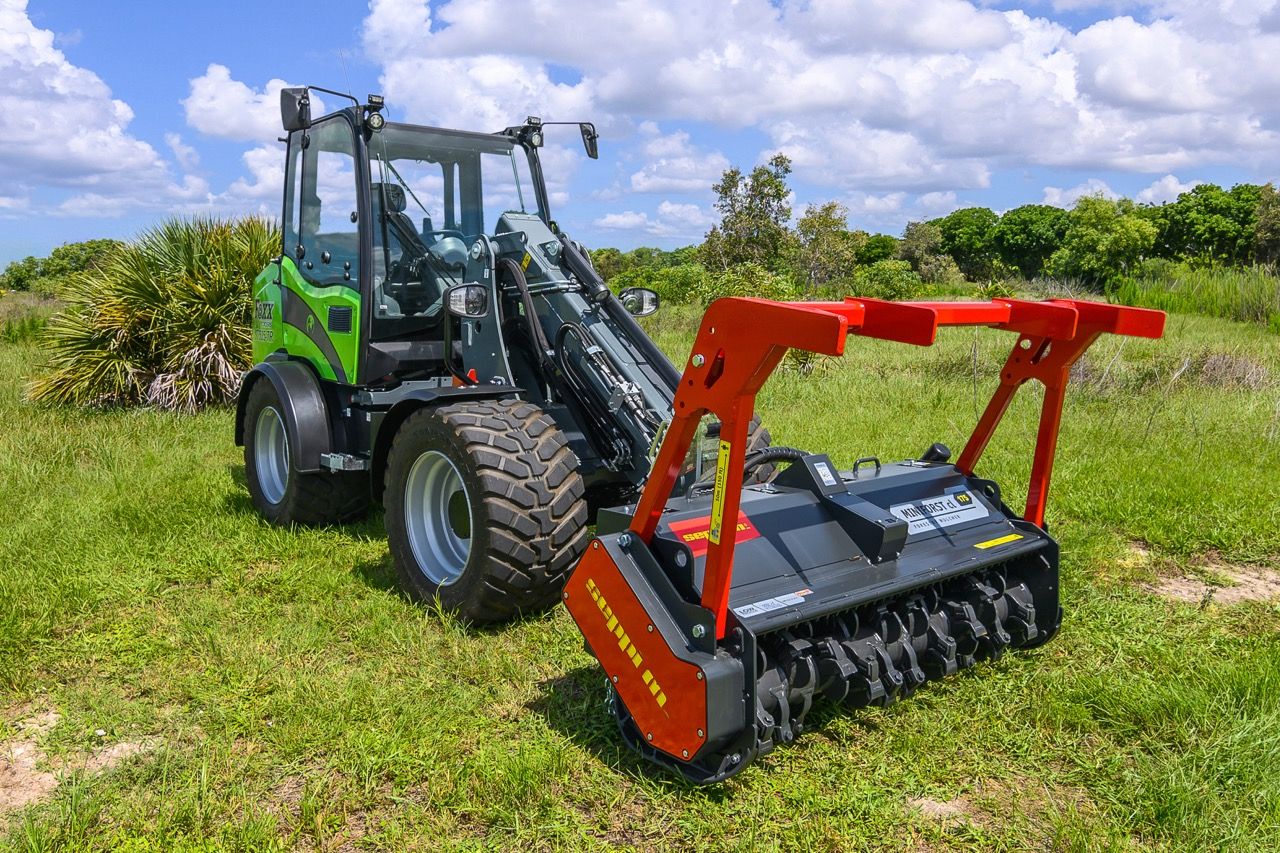What Is Horizontal Directional Drilling (HDD)?
Horizontal Directional Drilling (HDD) is a trenchless construction technique used to install underground pipelines, conduits, and cables without the need for open excavation. This method uses a surface-launched drilling rig to bore a guided, arc-shaped path underground, making it ideal for projects where minimal surface disruption is essential.
HDD is widely used in urban environments, environmentally sensitive areas, and locations where traditional trenching is impractical — such as beneath rivers, highways, and developed landscapes. It’s a three-phase process involving pilot drilling, reaming, and product pipe pullback.
Why Choose HDD Over Traditional Methods?
Horizontal Directional Drilling offers several significant advantages compared to open-cut trenching and other traditional excavation methods:
- Minimal Surface Disruption HDD allows underground utilities to be installed beneath roads, rivers, and landscaping without destroying the surface, preserving infrastructure and natural habitats.
- Cost-Effective Over Long Distances By reducing the need for restoration and traffic control, HDD often lowers total project costs, especially for long or complex bores.
- Environmentally Friendly HDD reduces soil disturbance, vegetation removal, and erosion — making it a preferred option for projects near water bodies or protected ecosystems.
- Suitable for a Wide Range of Soil Conditions With the right tooling and drilling fluids, HDD can successfully navigate through clay, sand, gravel, and even rock.
Pro Tip: HDD dramatically reduces the need for road closures and public disruption, making it the go-to method for installing utilities in high-traffic urban zones and critical infrastructure corridors.
Step-by-Step: How the HDD Process Works
Horizontal Directional Drilling is executed in three primary stages, each requiring specialised equipment and skilled operation. Understanding each phase helps ensure precision, safety, and project success.
1. Site Survey and Planning
Before drilling begins, a detailed site assessment is conducted. This includes reviewing utility maps, conducting soil tests, and designing the optimal bore path. Engineers assess potential obstacles, depth requirements, and environmental risks to ensure accuracy and compliance.
2. Pilot Bore Drilling
The process starts with a pilot bore using a steerable drill head. Guided by a locator system, the drill is steered along a pre-determined path, typically in a shallow arc to maintain precision and avoid underground obstructions.
3. Bore Path Tracking
During drilling, transmitters within the drill head send real-time data about depth, pitch, and direction. This data is read by an above-ground locator, allowing the operator to make precise adjustments.
4. Reaming and Hole Enlargement
Once the pilot hole is complete, the bore must be widened to accommodate the product pipe. This is done using reamers or hole openers that are pulled back through the borehole, gradually increasing its diameter.
5. Product Pipe Pullback
After the bore is reamed to the required size, the utility pipe—such as HDPE, steel, or conduit—is attached to a swivel and pulled through the borehole. The swivel prevents the pipe from twisting, ensuring smooth placement.
6. Drilling Fluid Management
Throughout the process, drilling fluids (commonly bentonite-based mud) are circulated to lubricate the drill, remove cuttings, and stabilize the bore. Proper mixing, recycling, and disposal are critical to environmental and operational safety.
Must-Have Equipment for HDD Projects
Successful horizontal directional drilling relies on a combination of precision planning and the right equipment. Each stage of the HDD process requires specialized tools designed for specific functions, soil conditions, and operational challenges.
Drill Rods
Drill rods connect the drill head to the drilling rig and transfer rotational force and torque. They must be strong, flexible, and durable enough to navigate curves and resist fatigue throughout the bore.
Drill Bits
The drill bit is the cutting head that initiates the bore. Bit types vary depending on soil conditions—ranging from soft earth bits to hardened rock bits. Choosing the right bit is essential for efficiency and bore control.
Transmitters and Locators
Transmitters embedded in the drill head send real-time signals to above-ground locators. These tools are essential for monitoring pitch, depth, and direction, ensuring the bore path stays on target and avoids underground utilities.
Reamers and Hole Openers
After completing the pilot bore, reamers are used to enlarge the borehole to the necessary diameter. Hole openers come in various styles to handle different soil types, including clay, sand, and fractured rock.
Swivels and Pull Heads
Swivels prevent torque from transferring to the product pipe during pullback, reducing stress on the pipe. Pull heads securely connect the pipe to the drill string for a safe and stable pull-through.
Drilling Fluids
Drilling fluids, often a bentonite-based mud, cool the drill head, carry cuttings out of the borehole, and stabilize the bore walls. Effective fluid management is critical to preventing bore collapse and maintaining productivity.
Mud Mixing Systems
Mixing systems are used to prepare drilling fluid on-site. These systems ensure the right consistency and chemical balance, allowing for optimal performance during both pilot and reaming phases.
Recycling and Separation Equipment
Separation systems remove solids from used drilling fluid so it can be recycled. This reduces environmental impact and fluid consumption, helping HDD crews work more efficiently and sustainably.
Pipe Handling and Material Support
Equipment like pipe rollers, cradles, and reel trailers are used to guide and manage the utility pipe during installation. These tools prevent bending, binding, or pipe damage during the pullback process.
Real-World Applications of HDD
Horizontal Directional Drilling is a trusted method for installing underground infrastructure across a wide range of industries. Its ability to place utilities beneath existing structures without disrupting surface activity makes it ideal for complex and high-traffic environments.
Telecommunications and Fiber Optic Networks
HDD is widely used to install fiber optic cables for internet and telecommunications providers. Crews can bore beneath roads, rivers, and residential areas without the need for trenching, reducing downtime for businesses and residents.
Water and Sewer Pipelines
Municipalities often rely on HDD to install or replace water and sewer lines in developed urban settings. It minimizes impact to streets, sidewalks, and landscaping while allowing precise control of pipe depth and alignment.
Gas and Oil Distribution
HDD enables the safe and secure placement of gas and oil pipelines beneath environmentally sensitive areas like wetlands, waterways, and protected land. This reduces surface disturbance and regulatory compliance risks.
Electrical Conduits
Power companies use HDD to place electrical conduits under highways, airports, and existing infrastructure without causing surface disruption. This is especially valuable in dense urban environments with limited access.
Renewable Energy Infrastructure
As solar farms, wind turbines, and other clean energy systems expand, HDD supports underground cable installation for power transmission. Its low environmental impact makes it a preferred method in renewable projects.
Road and Railway Crossings
When utility lines must cross beneath major roadways or active rail lines, HDD offers a non-disruptive solution. Bores can be completed without needing to shut down traffic or disturb pavement.
Safety & Best Practices in HDD
Horizontal Directional Drilling offers numerous advantages, but safe execution requires adherence to best practices and industry standards. From pre-drill preparation to final pipe pullback, every step must be handled with care to avoid costly delays, environmental issues, or injuries.
Pre-Bore Utility Locates
Before any drilling begins, crews must identify and mark all existing underground utilities. This is typically done through utility mapping and the use of electromagnetic or ground-penetrating radar. Striking a buried utility can lead to severe consequences, including service outages or legal penalties.
Site Assessment and Risk Planning
Each jobsite should be evaluated for soil conditions, surface obstacles, access points, and environmental concerns. Based on this assessment, operators can select the appropriate drill rig, tooling, and fluid management system. A job-specific safety plan should be documented and communicated to the crew.
Equipment Inspection and Maintenance
Regular equipment checks are essential to prevent mechanical failure. Drill rods, reamers, transmitters, and support systems should be inspected before and after each use. Worn or damaged parts should be replaced immediately to avoid accidents and unplanned downtime.
Drill Path Monitoring
During active drilling, the drill path must be monitored continuously. Transmitters and locators should be calibrated and checked for accuracy. Operators must document pitch, depth, and directional changes to ensure the bore remains on course and avoids hazards.
Mud Management and Environmental Control
Proper use of drilling fluids is critical not only for bore stability but also for environmental compliance. Crews must contain and recycle fluids, avoid unintentional returns (frac-outs), and prevent contamination of nearby water sources or soil.
Communication and Crew Training
Every crew member should be trained on site-specific procedures and emergency protocols. Clear communication between the drill operator, locator, and support crew ensures smooth coordination and minimizes the risk of errors.




